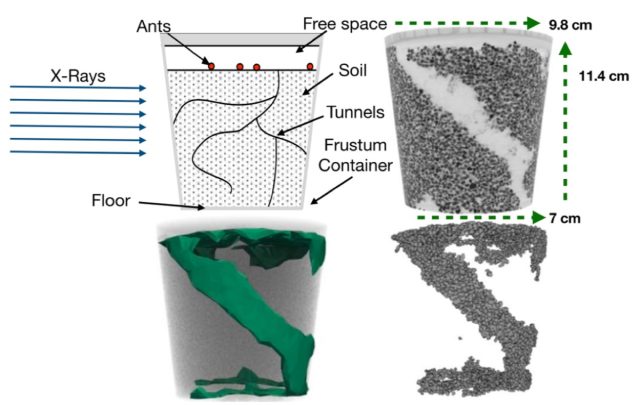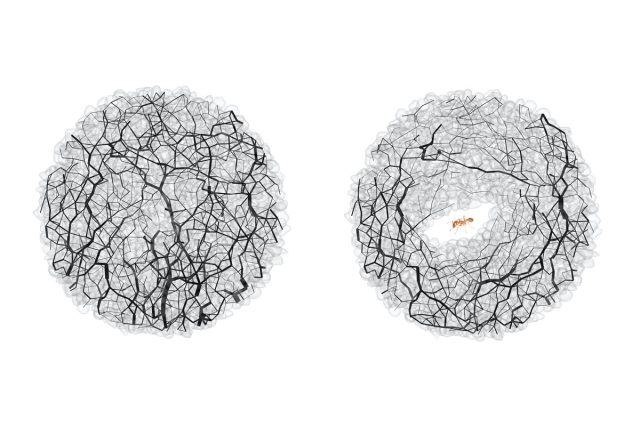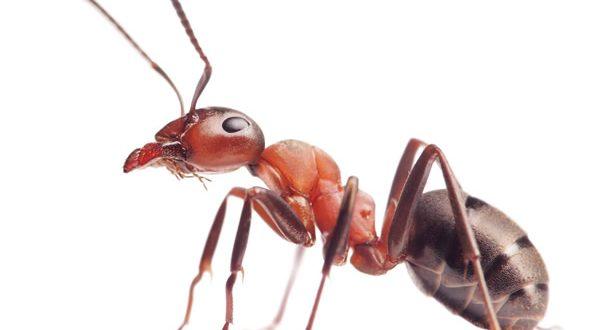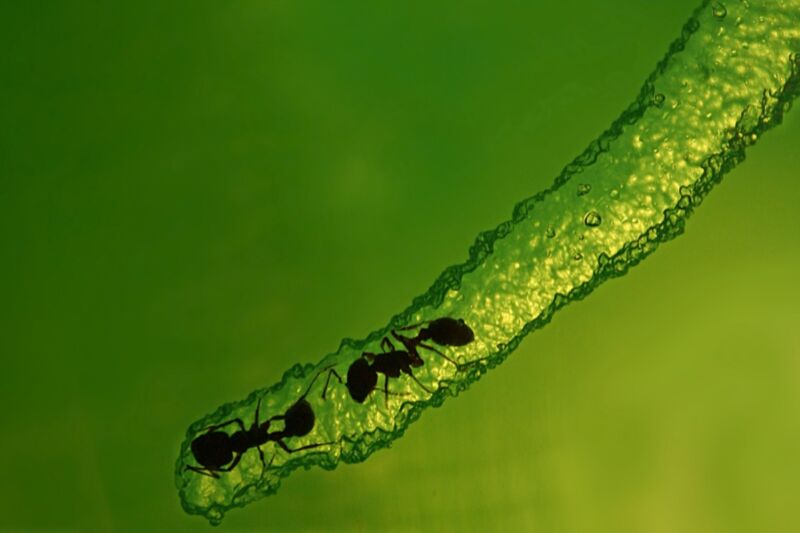Ants are prodigious diggers, constructing elaborate nests with multiple layers connected by an intricate network of tunnels, sometimes reaching depths of 25 feet. Now, a team of scientists from Caltech has used X-ray imaging to capture the process of how ants construct their tunnels. The scientists found that the ants have evolved to intuitively sense which grain particles they can remove while maintaining the stability of the structure, much like removing individual blocks in a game of Jenga. The team described their work in a new paper published in the Proceedings of the National Academy of Sciences.
Scientists interested in collective behavior have been studying ants for decades. That's because, as a group, ants act like a form of granular media. A few ants spaced well apart behave like individual ants. But pack enough of them closely together and they act more like a single unit, exhibiting both solid and liquid properties. You can pour fire ants from a teapot, for instance, or the ants can link together to build towers or floating rafts. Ants may be tiny critters with tiny brains, but these social insects are capable of collectively organizing themselves into a highly efficient community to ensure that the colony survives.
Several years ago, behavioral biologist Guy Theraulaz of the Institute for Advanced Study in Toulouse, France, and several colleagues combined laboratory experiments with Argentine ants and computer modeling to identify three simple rules governing the ants' tunneling behavior. To wit: (1) the ants picked up grains at a constant rate (about 2 grains every minute); (2) the ants preferentially dropped their grains near other grains to form pillars; and (3) ants typically chose grains marked with a chemical pheromone after being handled by other ants. Theraulaz et al. built a computer simulation based on those three rules and found that after a week, their virtual ants built a structure that closely resembled real ant nests. They concluded that those rules emerge from local interactions between individual ants, with no need for central coordination.
More recently, a 2020 paper found that the social dynamics of how division of labor emerges in an ant colony is similar to how political polarization develops in human social networks. Ants also excel at regulating their own traffic flow. A 2018 study by Daniel Goldman's group at Georgia Tech investigated how fire ants optimize their tunnel-digging efforts without causing traffic jams. As we reported at the time, the group concluded that when an ant encounters a tunnel in which other ants are already working, it retreats to find another tunnel. And only a small fraction of the colony is digging at any given time: 30 percent of them do 70 percent of the work.
David Hu's biolocomotion group at Georgia Tech has also studied fire ants. In 2019, he and his colleagues reported that fire ants can actively sense changes in forces acting upon their floating raft. The ants recognize different conditions of fluid flow and can adapt their behavior accordingly to preserve the raft's stability. A paddle moving through river water will create a series of swirling vortices (known as vortex shedding), causing the ant rafts to spin. These vortices can also exert extra forces on the raft, sufficient to break it apart. The changes in both centrifugal and shearing forces acting on the raft are quite small—maybe 2 percent to 3 percent the force of normal gravity. Yet somehow, the ants can sense these small shifts with their bodies.
This latest paper focuses on western harvester ants (Pogonomyrmex occidentalis), selected because of their prolific digging ability with soil grains at the millimeter scale. Co-author José Andrade, a mechanical engineer at Caltech, was inspired to explore tunneling ants after seeing examples of anthill art. The pieces are created by pouring some kind of molten metal, plaster, or cement into an ant mound, which flows through all the tunnels and eventually hardens. Then the surrounding soil is removed to reveal the final intricate structure. Andrade was so impressed that he started to wonder if ants actually "knew" how to dig those structures.

Andrade partnered with Caltech biological engineer Joe Parker for the project; Parker's research focuses on the ecological relationships of ants with other species. "We didn't interview any ants to ask if they know what they're doing, but we did start with the hypothesis that they dig in a deliberate way," said Andrade. "We hypothesized that maybe ants were playing Jenga."
In other words, the researchers suspected that the ants poked around in the soil hunting for loose grains to remove, in much the same way people look for loose blocks to remove from a Jenga tower, leaving the critical load-bearing pieces in place. Those blocks are part of what's known as a "force chain" that serves to jam the blocks (or granular soil particles, in the case of an anthill) together to create a stable structure.
For their experiments, Andrade and his colleagues mixed 500 ml of Quikrete soil with 20 ml of water and placed the mixture in several small cups of soil. The size of the cups was selected for how easily they could be placed inside a CT scanner. Through trial and error—starting with one ant and gradually increasing the number—the researchers determined the number of ants needed to achieve the optimal excavation rate: 15.
The team took four-minute, half-resolution scans every 10 minutes while the ants were tunneling to monitor their progress. From the resulting 3D images, they created a "digital avatar" for every particle in the sample, capturing each grain's shape, position, and orientation—all of which can significantly influence the distribution of forces in the soil samples. The researchers were also able to figure out the order in which each grain was removed by the ants by comparing images taken at different instances in time.

The ants were not always cooperative when it came to diligently digging their tunnels. "They're sort of capricious," Andrade said. "They dig whenever they want to. We would put these ants in a container, and some would start digging right away, and they would make this amazing progress. But others—it would be hours and they wouldn't dig at all. And some would dig for a while and then would stop and take a break."
Andrade and Parker noticed a few emerging patterns in their analysis. For instance, the ants usually dug along the inside edges of the cups—an efficient strategy, since the sides of the cups could serve as part of the tunneling structure, saving the ants a bit of effort. The ants also favored straight lines for their tunnels, a tactic that optimizes efficiency. And the ants tended to dig their tunnels as steeply as possible. The steepest possible limit in a granular medium like soil is called the "angle of repose"; exceed that angle, and the structure will collapse. Somehow, the ants can sense that critical threshold, making sure their tunnels never exceed the angle of repose.
As for the underlying physics, the team discovered that as the ants removed grains of soil to dig their tunnels, the force chains acting upon the structure rearranged themselves from a randomized distribution to form a kind of liner around the outside of a tunnel. This redistribution of forces strengthens the tunnel's existing walls and relieves pressure exerted by grains at the tunnel's end, making it easier for the ants to remove those grains to extend the tunnel even further.
"It's been a mystery in both engineering and in ant ecology how ants build these structures that persist for decades," said Parker. "It turns out that by removing grains in this pattern that we observed, the ants benefit from these circumferential force chains as they dig down." The ants tap the individual grains to assess the mechanical forces being exerted upon them.
Parker thinks of it as a kind of behavioral algorithm. "That algorithm does not exist within a single ant," he said. "It's this emergent colony behavior of all these workers acting like a superorganism. How that behavioral program is spread across the tiny brains of all these ants is a wonder of the natural world we have no explanation for."
DOI: PNAS, 2021. 10.1073/pnas.2102267118 (About DOIs).



3175x175(CURRENT).thumb.jpg.b05acc060982b36f5891ba728e6d953c.jpg)


Recommended Comments
There are no comments to display.
Join the conversation
You can post now and register later. If you have an account, sign in now to post with your account.
Note: Your post will require moderator approval before it will be visible.